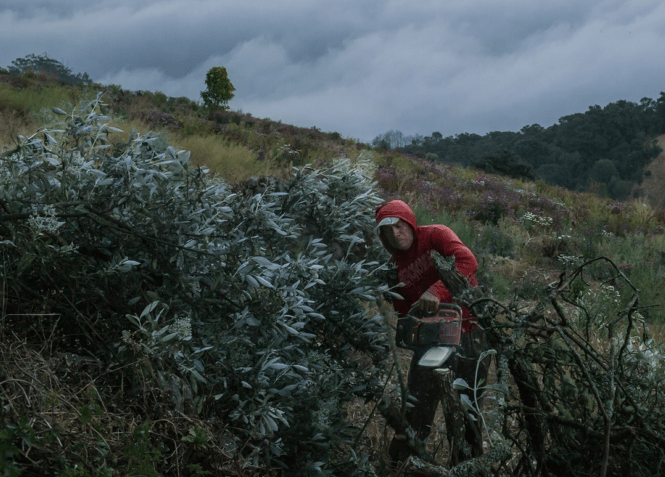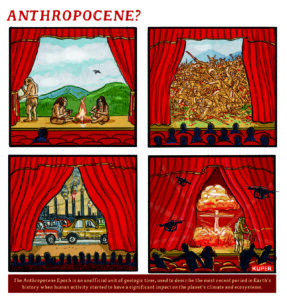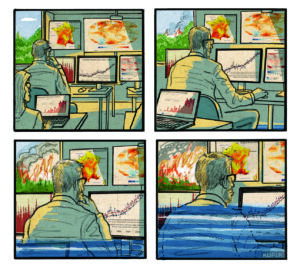The Inconvenient Truth About Migration the Media Brush Off
Corporate media downplays the fact that forced migration of people escaping deteriorating conditions is driven, in part, by climate disruption. Screen shot / New Yorker
Screen shot / New Yorker

Washington Post (4/16/19)
Journalists routinely dehumanize human beings crossing the southern border by comparing them to natural disasters like a “flood” or “deluge.” But while migration has always been a natural phenomenon, the increasingly forced migration of people escaping deteriorating conditions is an unnatural disaster driven, in part, by climate disruption.
The New Yorker (4/3/19) reported on how droughts, floods and changes to weather patterns have contributed to crop susceptibility to diseases and pests, degraded soil quality and shortened growing seasons. Reuters (5/2/19) covered UN estimates that 2.2 million people Central Americans have been affected by poor harvests as a result of climate change, with up to four in every five families having to sell animals and farm equipment to buy food in the past year.
It would be easy for even a diligent news consumer to not know that climate change is one of the central factors driving refugees to cross the border, since it’s usually not mentioned at all in most alarmist reports about the so-called “border crisis” (New York Times, 4/10/19; Wall Street Journal, 5/8/19). In fact, although a few good articles have been dedicated to making the connection (e.g., New York Times, 4/13/19; Washington Post, 4/16/19), it’s usually absent even among reports purporting to explain why people are making the dangerous journey.

Politico (3/28/19)
Politico’s “Here’s What’s Driving the ‘Crisis’ at the Border” (3/28/19) and Vox’s “The Border Is in Crisis. Here’s How It Got This Bad” (4/11/19) both correctly note that the Trump administration’s claims about “unprecedented numbers of undocumented immigrants” crossing the border from Central American countries like Guatemala, Honduras and El Salvador are “untrue,” because, as Vox put it, the
total number of people coming into the US without papers is still lower than it was for most of the 20th century, and substantially lower its turn-of-the-century peak.
However, the strained resources from more families and children crossing the border, as well as the complications of the asylum process, figure heavily into their explanation for how the crisis “got so bad”—rather than the five-year drought ruining the crops of maize, coffee, bananas and beans depended on by mostly subsistence farmers, also known as campesinos, in Central America. The drought is also disrupting the traditional seasonal migration to harvest coffee in Honduras that Central American families have used to ease poverty, forcing them to flee to the US instead (Al-Jazeera, 5/13/19).
Politico’s report explained the border crisis with statements from Republican and Border Patrol officials noting how the “rise in families” and the “greater volume of children among the new Central American migrants” are creating a “capacity crisis,” unlike the less-needy single adult males from Mexico who “constituted most border migrants” a decade earlier, with increased asylum applications creating a longer immigration process.
Vox’s report observed that “we don’t have apples-to-apples data,” because there’s “substantial evidence that the raw number of children and families entering the US is higher than it’s ever been,” while also noting that “crushing poverty” and “gang violence” are factors, in addition to many migrants themselves not knowing “what asylum is,” or why they “might not qualify for it.”

Atlantic (6/26/18)
The Atlantic’s account, “Today’s Migrant Flow Is Different” (6/26/18), likewise explained that “the crux of the recent crisis at the border” is that there are
fewer male migrants in their 20s or 30s making the crossing, and many more families, newborns, children and pregnant women escaping life-or-death situations as much as poverty.
That’s how the outlet differentiated today’s “migrant flow” from previous decades, where Central Americans were fleeing “economic misery in their war-torn states.” The Atlantic actually mentioned that “previous US policies contributed to the extreme insecurity in their home countries,” but only discussed the US policy of deporting “tens of thousands of convicted criminals to Central America in the early 2000s,” and nothing else regarding why “thousands of Central American families” are “stuck between a rock and a hard place.”
Time’s “‘There Is No Way We Can Turn Back’: Why Thousands of Refugees Will Keep Coming to America Despite Trump’s Crackdown” (6/21/18) and NBC’s “Why Are So Many Migrants Crossing the US border? It Often Starts With an Escape From Violence in Central America” (6/20/18) described, not inaccurately but incompletely, migrants escaping “high levels of violence” from organized crime groups like “street gangs” and “drug cartels,” in addition to citing “corruption, weak and unstable government institutions,” and the “unrelenting turmoil of the region.”
NBC’s report mentions that “the conditions” in Guatemala, El Salvador and Honduras came to “Americans’ attention in full force” in 2014, when “tens of thousands of children arrived on their own” at the US border, without discussing that year’s climate change–related drought. A year later, NBC (7/9/19) would note 2014 as the year the drought began, as it cited immigration analysts and UN reports finding that “roughly half” of all adults apprehended at the border worked “in agriculture,” with a “lack of food” being the primary reason people leave.

Bloomberg (7/5/19)
Bloomberg (7/5/19) offered the victim-blaming headline “Why Roots of US Border Crisis Lie South of Mexico,” and noted that Honduras and El Salvador have among the “highest murder rates in the world.” It depicted Central American migrants as seeking economic opportunity, noting that 60 percent of the population in Honduras and Guatemala lives below the national poverty line, and characterizing those countries as “a hotbed of poverty, corruption, gang violence and extortion.”
In all these reports, the US’s contributions to the violence and corruption in Central America during the Cold War, and more recent US support for a 2009 military coup in Honduras deposing the democratically elected left-wing President Manuel Zelaya, and its funding for death squads in the country, are completely obscured. This despite the evidence (Migration Policy Institute, 4/1/06) that US-backed violence in Guatemala, Honduras and El Salvador during the Cold War “institutionalized” a migration pattern to North America that had been “very minor” beforehand.
But if these reports shrouded the connection between US foreign policy and the “violence” and “unrelenting turmoil” in the region, they more deeply buried the connection between increasing violence and climate change.
In fact, the Pentagon has long viewed climate change as a “threat multiplier,” and an indirect factor that could prompt outbreaks of violence in countries already staggering under the weight of other problems (Guardian, 3/31/14). Military planners point to the Syrian civil war—which has killed hundreds of thousands—as an example of how climate change contributes to violent conflict, with the worst drought there in 500 years creating massive internal displacement that led to government repression and sectarian violence (Inside Climate News, 6/13/19).

Guardian (10/30/18)
And while poverty is often featured along with “violence” among the list of things Central American refugees are fleeing, corporate media rarely discuss why so many people there are impoverished, and the connection to the ongoing climate catastrophe. In contrast, the Guardian (10/30/18) informed readers:
“The focus on violence is eclipsing the big picture—which is that people are saying they are moving because of some version of food insecurity,” said Robert Albro, a researcher at the Center for Latin American and Latino Studies at American University.
“The main reason people are moving is because they don’t have anything to eat. This has a strong link to climate change—we are seeing tremendous climate instability that is radically changing food security in the region.”
Migrants don’t often specifically mention “climate change” as a motivating factor for leaving, because the concept is so abstract and long-term, Albro said. But people in the region who depend on small farms are painfully aware of changes to weather patterns that can ruin crops and decimate incomes.
Guatemala, Honduras and El Salvador are part of the Dry Corridor, a region where droughts, tropical storms and flash floods are common, but climate change is influencing the severity and frequency of these disasters, and consecutive droughts can devastate the livelihoods of campesinos completely dependent on what they grow for survival. Unlike in the US and Europe, there are no crop insurance or aid programs, and often no irrigation systems either, to assist people in difficult times (Public Radio International, 2/6/19).
Climate scientist Noah Diffenbaugh (Grist, 4/23/19)—lead author of a Stanford University study finding that the economic gap between the richest and poorest countries is about 25 percent greater than it would’ve been without anthropogenic climate change—stated that “most of the poorest countries on Earth are considerably poorer than they would’ve been without global warming.”
Climate change is also a major—yet often omitted—reason for the record number of African migrants crossing the US/Mexican border fleeing violence and poverty. The EU has exacerbated this, mirroring the Trump administration’s policy of making it as painful as possible for refugees to apply for asylum by making civil war–torn Libya the main processing center for applications (Foreign Policy, 6/26/19).
The UN’s 2019 Sustainable Development Goals Report found that “extreme poverty today is concentrated and overwhelmingly affects rural populations,” and that it’s increasingly being “exacerbated by violent conflicts and climate change.” It also found that 413 million out of the estimated 736 million people still living in extreme poverty are in Sub-Saharan Africa, where most of the new migrants are coming from, and the region with “the highest prevalence of hunger,” as the number of undernourished people increased from 195 million in 2014 to 237 million in 2017.

CNN (4/1/19)
The UN’s Food and Agricultural Organization found that the 2015–16 El Niño phenomenon afflicting Central America—a warming of the Pacific Ocean surface that causes hotter and drier conditions there—was the strongest it’s been in 50 years, and was also affecting Sub-Saharan Africa’s food security, with 32 million people in the region unable to acquire food in 2016 due to dry weather conditions. The FAO (CNN, 4/1/19) noted that “evolving climatic patterns characterized by cyclic droughts, floods and cyclones have become more frequent in Southern Africa.”
Corporate media downplaying the ongoing climate catastrophe’s creation of large numbers of climate refugees encourages fatal inaction. The UN is warning of more than 120 million people pushed into poverty by 2030, and a “climate apartheid” scenario where the wealthy countries most responsible for carbon emissions are leaving the rest of the world with a stark “choice” between starvation and migration.
This is not one story, fit for the occasional Sunday piece, but many everyday stories, of which human movement across national borders is only one. Media have a responsibility to not only tell these stories, but to link them to climate disruption, if they intend to be part not of the problem but of the solution.
Your support matters…Independent journalism is under threat and overshadowed by heavily funded mainstream media.
You can help level the playing field. Become a member.
Your tax-deductible contribution keeps us digging beneath the headlines to give you thought-provoking, investigative reporting and analysis that unearths what's really happening- without compromise.
Give today to support our courageous, independent journalists.









You need to be a supporter to comment.
There are currently no responses to this article.
Be the first to respond.